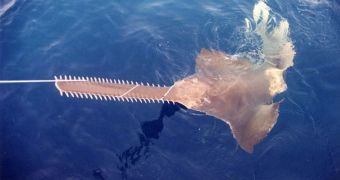More than six weeks ago, oil began gushing into the Gulf of Mexico from three wellheads more than a mile under the surface of the sea. Since then, vast amounts of crude have risen to the surface, and have also formed massive underwater plumes, of which only a handful were discovered thus far. This massive ecological disaster, recently classified by authorities as the largest in the history of the United States, is taking a massive toll on threatened, endangered and critically endangered species living in the Gulf of Mexico, ecology experts say, quoted by LiveScience.
“You don't have to be a marine biologist to know that the Gulf oil spill is an environmental disaster of the first order,” explains the editor-in-chief of the FASEB Journal, Gerald Weissman. The publication is being edited by the Federation of the American Societies for Experimental Biology. One of the primary species at risk from the oil slick is the sawfish, of which several types are already at critical risk, and on the brink of extinction. Numerous other species of fish and birds, some of which only live and breed in the natural habitats on the Louisiana coastline, are also at risk. Their ecosystems have already been contaminated by the oil spilling from the former site of the BP-operated Deepwater Horizon rig.
“The oil spill will not only have very dire effects on such highly visible creatures as seabirds and dolphins, but also threatens a multitude of bottom-dwelling organisms including the smalltooth sawfish, which already is in considerable trouble as its range diminished and its numbers dwindled,” says ichthyologist and sawfish expert George Burgess, who is based at the University of Florida in Gainesville. Another species currently under threat is the largetooth sawfish, which experts proposed to be classified as endangered on May 7, 2010, a couple of weeks after the spill began.
Its relative, the smalltooth sawfish, will most likely feel the impact of the crude slicks even more severely. Its numbers and range have already been drastically reduced, even before oil began contaminating the Gulf. In its heyday, the species occupied an area stretching from New York to Texas, but now it only survives in a small region around the southern Florida coastline. Though relatively far away from the site of the accident, the area is in grave danger, given that plumes of oil have already entered the Loop Current, a deep-water oceanic current that moves east through the Gulf, all the way to Florida, and then the Gulf Stream. The coral reefs in southern Florida are also endangered by the oil.
“Stuff leaching from the ocean floor is the worst environmental challenge a coral reef can face,” argues Weissman. “As oil gets caught up in the Loop Current, it will be pulled down into the Gulf Stream, which goes right by Key West on its way up the US East Coast. The opportunities for serious ecological problems are mind-boggling, with dire implications for what's left of [the sawfish species] in the northwest Atlantic Ocean if the oil reaches critical mangrove habitat,” Burgess adds.

 14 DAY TRIAL //
14 DAY TRIAL //